Matplotlib中Artist对象的变换设置检查:深入理解is_transform_set()方法
参考:Matplotlib.artist.Artist.is_transform_set() in Python
Matplotlib是Python中最流行的数据可视化库之一,它提供了丰富的绘图功能和灵活的自定义选项。在Matplotlib的架构中,Artist对象扮演着至关重要的角色,它们是构建可视化图形的基本单元。本文将深入探讨Matplotlib中Artist对象的一个重要方法:is_transform_set()。我们将详细介绍这个方法的作用、使用场景以及如何在实际绘图中应用它。
1. Artist对象简介
在深入了解is_transform_set()方法之前,我们需要先了解Matplotlib中的Artist对象。Artist是Matplotlib中所有可视元素的基类,包括图形、轴、线条、文本等。每个Artist对象都可以有自己的变换(transform),这些变换定义了对象在图形中的位置和形状。
以下是一个简单的示例,展示了如何创建一个基本的Artist对象:
import matplotlib.pyplot as plt
from matplotlib.artist import Artist
fig, ax = plt.subplots()
artist = Artist()
ax.add_artist(artist)
plt.title("Basic Artist Example - how2matplotlib.com")
plt.show()
Output:
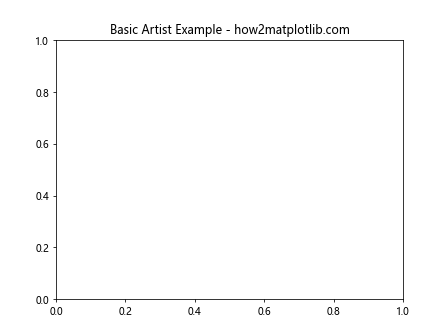
在这个例子中,我们创建了一个空的Artist对象并将其添加到轴上。虽然这个Artist对象本身不可见,但它展示了Artist对象的基本用法。
2. 变换(Transform)的概念
变换是Matplotlib中的一个核心概念,它定义了如何将数据坐标转换为显示坐标。每个Artist对象都可以有自己的变换,这使得我们可以灵活地控制对象在图形中的位置和形状。
以下是一个使用变换的简单示例:
import matplotlib.pyplot as plt
import matplotlib.transforms as transforms
fig, ax = plt.subplots()
circle = plt.Circle((0.5, 0.5), 0.2)
ax.add_artist(circle)
# 应用平移变换
t = transforms.Affine2D().translate(0.2, 0.2) + ax.transData
circle.set_transform(t)
plt.title("Transform Example - how2matplotlib.com")
plt.show()
Output:
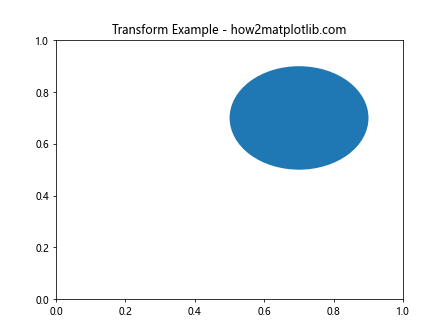
在这个例子中,我们创建了一个圆形,并对其应用了平移变换,将其向右上方移动。
3. is_transform_set()方法介绍
is_transform_set()是Artist类的一个方法,用于检查Artist对象是否已经设置了自定义的变换。这个方法返回一个布尔值:如果已经设置了变换,返回True;否则返回False。
以下是一个使用is_transform_set()方法的基本示例:
import matplotlib.pyplot as plt
from matplotlib.patches import Rectangle
fig, ax = plt.subplots()
rect = Rectangle((0.1, 0.1), 0.5, 0.5)
ax.add_patch(rect)
print(f"Transform set: {rect.is_transform_set()}")
plt.title("is_transform_set() Example - how2matplotlib.com")
plt.show()
Output:
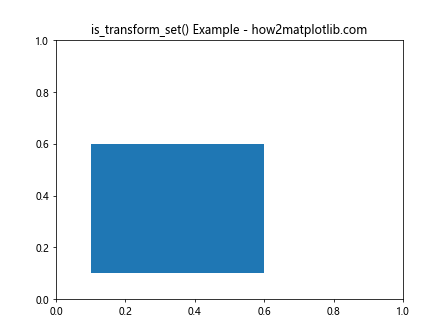
在这个例子中,我们创建了一个矩形对象,并检查它是否已经设置了变换。由于我们没有显式地设置变换,is_transform_set()将返回False。
4. 设置和检查变换
让我们更深入地探讨如何设置变换并使用is_transform_set()方法进行检查:
import matplotlib.pyplot as plt
import matplotlib.transforms as transforms
from matplotlib.patches import Rectangle
fig, ax = plt.subplots()
rect = Rectangle((0.1, 0.1), 0.3, 0.3, facecolor='red')
ax.add_patch(rect)
print(f"Before setting transform: {rect.is_transform_set()}")
# 设置变换
t = transforms.Affine2D().rotate_deg(45) + ax.transData
rect.set_transform(t)
print(f"After setting transform: {rect.is_transform_set()}")
plt.title("Transform Setting and Checking - how2matplotlib.com")
plt.show()
Output:
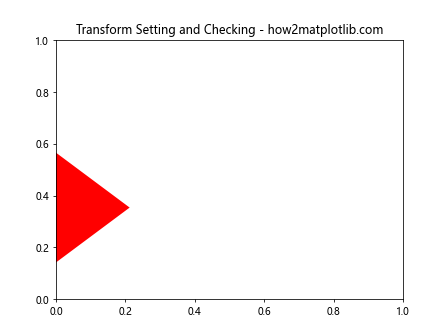
在这个例子中,我们首先创建了一个矩形,然后检查它是否有设置变换。接着,我们设置了一个旋转变换,并再次检查变换是否已设置。你会看到第二次检查返回True。
5. 使用is_transform_set()进行条件操作
is_transform_set()方法的一个常见用途是在绘图代码中进行条件操作。例如,我们可以根据对象是否已设置变换来决定是否应用默认变换:
import matplotlib.pyplot as plt
import matplotlib.transforms as transforms
from matplotlib.patches import Circle
fig, ax = plt.subplots()
circle1 = Circle((0.3, 0.3), 0.1, facecolor='blue')
circle2 = Circle((0.7, 0.7), 0.1, facecolor='red')
ax.add_patch(circle1)
ax.add_patch(circle2)
# 只为circle2设置变换
t = transforms.Affine2D().scale(1.5) + ax.transData
circle2.set_transform(t)
for circle in [circle1, circle2]:
if not circle.is_transform_set():
print(f"Applying default transform to {circle}")
circle.set_transform(ax.transData)
plt.title("Conditional Transform Application - how2matplotlib.com")
plt.show()
Output:
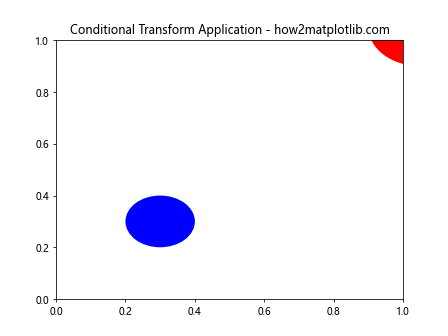
在这个例子中,我们创建了两个圆,只为其中一个设置了变换。然后,我们使用is_transform_set()方法检查每个圆是否已设置变换,如果没有,就应用默认的数据变换。
6. 复合变换和is_transform_set()
Matplotlib允许我们创建复合变换,即多个变换的组合。让我们看看在这种情况下is_transform_set()的行为:
import matplotlib.pyplot as plt
import matplotlib.transforms as transforms
from matplotlib.patches import Rectangle
fig, ax = plt.subplots()
rect = Rectangle((0.1, 0.1), 0.3, 0.3, facecolor='green')
ax.add_patch(rect)
print(f"Before setting transform: {rect.is_transform_set()}")
# 创建复合变换
t1 = transforms.Affine2D().rotate_deg(30)
t2 = transforms.Affine2D().scale(1.5)
t = t1 + t2 + ax.transData
rect.set_transform(t)
print(f"After setting composite transform: {rect.is_transform_set()}")
plt.title("Composite Transform and is_transform_set() - how2matplotlib.com")
plt.show()
Output:
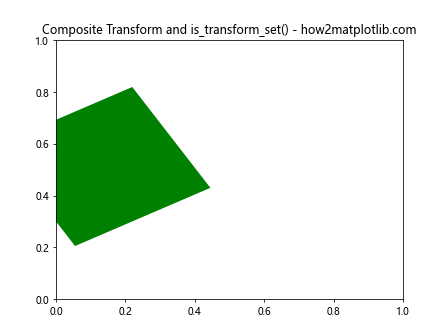
在这个例子中,我们创建了一个复合变换,包括旋转和缩放。即使是复合变换,is_transform_set()也会正确地返回True。
7. 动态更新变换
is_transform_set()方法在动态更新图形时特别有用。我们可以使用它来检查是否需要重新设置变换:
import matplotlib.pyplot as plt
import matplotlib.transforms as transforms
from matplotlib.patches import Rectangle
import numpy as np
fig, ax = plt.subplots()
rect = Rectangle((0.1, 0.1), 0.3, 0.3, facecolor='purple')
ax.add_patch(rect)
for i in range(5):
if not rect.is_transform_set():
print("Setting initial transform")
rect.set_transform(ax.transData)
else:
print("Updating existing transform")
current_transform = rect.get_transform()
new_transform = transforms.Affine2D().rotate_deg(10) + current_transform
rect.set_transform(new_transform)
plt.title(f"Dynamic Transform Update {i} - how2matplotlib.com")
plt.draw()
plt.pause(1)
plt.show()
Output:
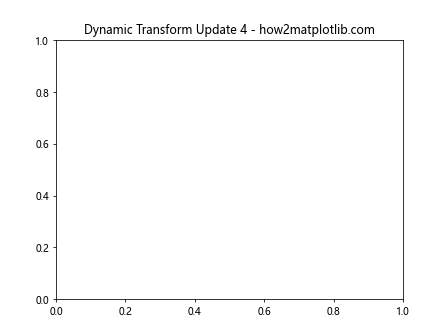
这个例子展示了如何在循环中动态更新对象的变换。我们使用is_transform_set()来检查是否需要设置初始变换,或者更新现有的变换。
8. 自定义Artist类和is_transform_set()
我们还可以创建自定义的Artist类,并在其中使用is_transform_set()方法:
import matplotlib.pyplot as plt
import matplotlib.transforms as transforms
from matplotlib.artist import Artist
class CustomArtist(Artist):
def __init__(self, xy=(0, 0)):
super().__init__()
self.xy = xy
def draw(self, renderer):
if not self.is_transform_set():
print("No custom transform set, using default")
self.set_transform(self.axes.transData)
gc = renderer.new_gc()
transform = self.get_transform()
txy = transform.transform(self.xy)
renderer.draw_marker(gc, txy[0], txy[1], 'm', 10)
gc.restore()
fig, ax = plt.subplots()
custom_artist = CustomArtist((0.5, 0.5))
ax.add_artist(custom_artist)
plt.title("Custom Artist with is_transform_set() - how2matplotlib.com")
plt.show()
在这个自定义Artist类中,我们在draw方法中使用is_transform_set()来检查是否需要设置默认变换。
9. 在动画中使用is_transform_set()
is_transform_set()方法在创建动画时也非常有用,特别是当我们需要在每一帧中更新对象的变换时:
import matplotlib.pyplot as plt
import matplotlib.transforms as transforms
from matplotlib.patches import Rectangle
import matplotlib.animation as animation
fig, ax = plt.subplots()
rect = Rectangle((0.1, 0.1), 0.3, 0.3, facecolor='orange')
ax.add_patch(rect)
def animate(frame):
if not rect.is_transform_set():
print("Setting initial transform")
rect.set_transform(ax.transData)
else:
print(f"Updating transform for frame {frame}")
current_transform = rect.get_transform()
new_transform = transforms.Affine2D().rotate_deg(frame * 5) + current_transform.frozen()
rect.set_transform(new_transform)
return rect,
ani = animation.FuncAnimation(fig, animate, frames=72, interval=50, blit=True)
plt.title("Animation with is_transform_set() - how2matplotlib.com")
plt.show()
Output:
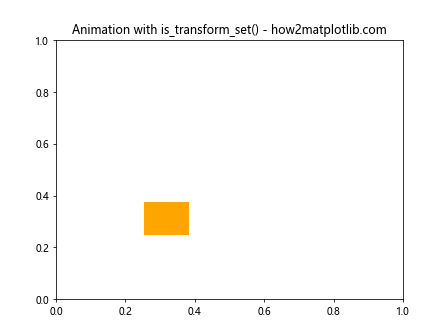
在这个动画示例中,我们使用is_transform_set()来检查是否需要设置初始变换,然后在每一帧中更新变换以实现旋转效果。
10. 处理多个Artist对象
当处理多个Artist对象时,is_transform_set()可以帮助我们区分哪些对象需要设置变换:
import matplotlib.pyplot as plt
import matplotlib.transforms as transforms
from matplotlib.patches import Circle, Rectangle, Ellipse
fig, ax = plt.subplots()
artists = [
Circle((0.2, 0.2), 0.1, facecolor='red'),
Rectangle((0.5, 0.5), 0.2, 0.3, facecolor='blue'),
Ellipse((0.8, 0.8), 0.2, 0.1, facecolor='green')
]
for artist in artists:
ax.add_patch(artist)
# 只为一些对象设置变换
artists[1].set_transform(transforms.Affine2D().rotate_deg(45) + ax.transData)
for i, artist in enumerate(artists):
if artist.is_transform_set():
print(f"Artist {i} has a custom transform")
else:
print(f"Setting default transform for Artist {i}")
artist.set_transform(ax.transData)
plt.title("Multiple Artists and is_transform_set() - how2matplotlib.com")
plt.show()
Output:
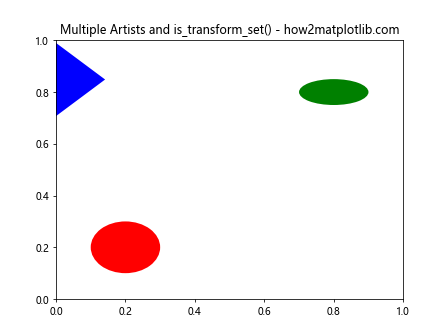
在这个例子中,我们创建了多个不同类型的Artist对象,并使用is_transform_set()来检查哪些对象需要设置默认变换。
11. 嵌套Artist对象和变换
在某些情况下,我们可能会遇到嵌套的Artist对象。让我们看看在这种情况下is_transform_set()的行为:
import matplotlib.pyplot as plt
import matplotlib.transforms as transforms
from matplotlib.patches import Rectangle
fig, ax = plt.subplots()
outer_rect = Rectangle((0.1, 0.1), 0.8, 0.8, facecolor='lightblue')
inner_rect = Rectangle((0.3, 0.3), 0.4, 0.4, facecolor='pink')
ax.add_patch(outer_rect)
ax.add_patch(inner_rect)
# 为外部矩形设置变换
outer_rect.set_transform(transforms.Affine2D().scale(0.8) + ax.transData)
print(f"Outer rectangle transform set: {outer_rect.is_transform_set()}")
print(f"Inner rectangle transform set: {inner_rect.is_transform_set()}")
# 将内部矩形的变换设置为外部矩形的变换
inner_rect.set_transform(outer_rect.get_transform())
print(f"Inner rectangle transform set after update: {inner_rect.is_transform_set()}")
plt.title("Nested Artists and Transforms - how2matplotlib.com")
plt.show()
Output:
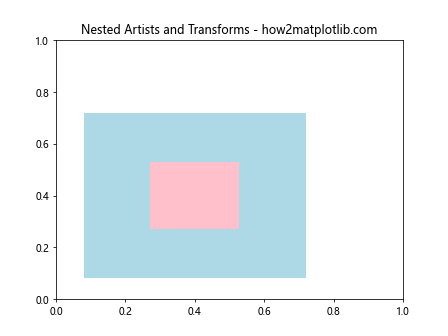
这个例子展示了如何处理嵌套的Artist对象,以及如何使用is_transform_set()来检查它们的变换状态。
12. 在交互式绘图中使用is_transform_set()
is_transform_set()方法在交互式绘图中也非常有用,特别是当我们需要根据用户输入动态更新图形时:
import matplotlib.pyplot as plt
import matplotlib.transforms as transforms
from matplotlib.patches import Rectangle
fig, ax = plt.subplots()
rect = Rectangle((0.1, 0.1), 0.3, 0.3, facecolor='yellow')
ax.add_patch(rect)
def on_click(event):
if not rect.is_transform_set():
print("Setting initial transform")
rect.set_transform(ax.transData)
else:
print("Updating transform")
current_transform = rect.get_transform()
new_transform = transforms.Affine2D().translate(event.xdata - 0.1, event.ydata - 0.1) + ax.transData
rect.set_transform(new_transform)
fig.canvas.draw()
fig.canvas.mpl_connect('button_press_event', on_click)
plt.title("Interactive Plot with is_transform_set() - how2matplotlib.com")
plt.show()
Output:
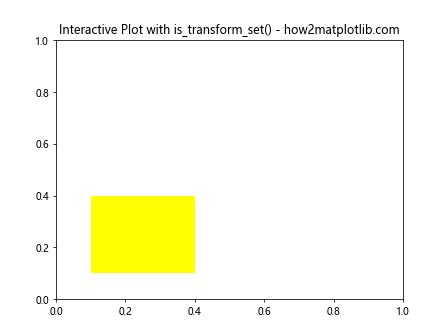
在这个交互式示例中,我们使用is_transform_set()来检查是否需要设置初始变换,然后根据用户的点击位置更新矩形的位置。
13. 在子图中使用is_transform_set()
当使用子图时,is_transform_set()方法可以帮助我们确保每个子图中的Artist对象都有正确的变换:
import matplotlib.pyplot as plt
import matplotlib.transforms as transforms
from matplotlib.patches import Circle
fig, (ax1, ax2) = plt.subplots(1, 2, figsize=(10, 5))
circle1 = Circle((0.5, 0.5), 0.2, facecolor='red')
circle2 = Circle((0.5, 0.5), 0.2, facecolor='blue')
ax1.add_patch(circle1)
ax2.add_patch(circle2)
# 只为第二个圆设置变换
circle2.set_transform(transforms.Affine2D().scale(1.5) + ax2.transData)
for ax, circle in zip([ax1, ax2], [circle1, circle2]):
if not circle.is_transform_set():
print(f"Setting default transform for circle in {ax}")
circle.set_transform(ax.transData)
else:
print(f"Custom transform already set for circle in {ax}")
ax1.set_title("Subplot 1")
ax2.set_title("Subplot 2")
fig.suptitle("Subplots and is_transform_set() - how2matplotlib.com")
plt.show()
Output:
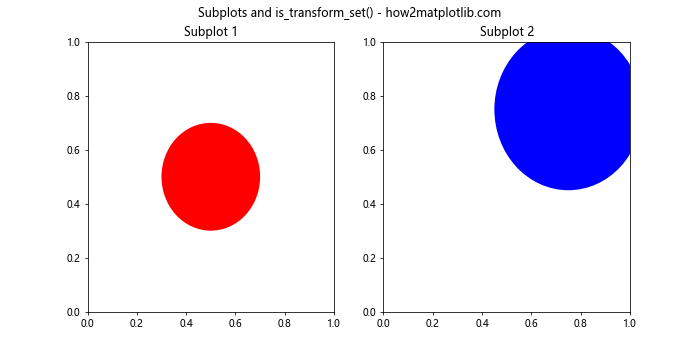
这个例子展示了如何在多个子图中使用is_transform_set()来管理Artist对象的变换。
14. 在3D图形中使用is_transform_set()
虽然is_transform_set()主要用于2D图形,但它在3D图形中也有应用。让我们看一个例子:
import matplotlib.pyplot as plt
import matplotlib.transforms as transforms
from mpl_toolkits.mplot3d import Axes3D
from mpl_toolkits.mplot3d.art3d import Poly3DCollection
fig = plt.figure()
ax = fig.add_subplot(111, projection='3d')
vertices = [(0, 0, 0), (1, 0, 0), (1, 1, 0), (0, 1, 0), (0.5, 0.5, 1)]
poly = Poly3DCollection([vertices], facecolors='cyan', alpha=0.8)
ax.add_collection3d(poly)
print(f"Transform set for 3D object: {poly.is_transform_set()}")
if not poly.is_transform_set():
print("Setting default transform for 3D object")
poly.set_transform(ax.get_transform())
ax.set_xlim(0, 1)
ax.set_ylim(0, 1)
ax.set_zlim(0, 1)
plt.title("3D Plot and is_transform_set() - how2matplotlib.com")
plt.show()
Output:
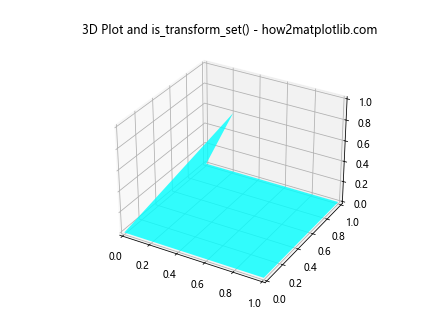
这个例子展示了如何在3D图形中使用is_transform_set()来检查和设置3D对象的变换。
15. 在自定义投影中使用is_transform_set()
Matplotlib支持自定义投影,在这种情况下,is_transform_set()可以帮助我们确保Artist对象使用正确的变换:
import matplotlib.pyplot as plt
import matplotlib.transforms as transforms
from matplotlib.projections import PolarAxes
from matplotlib.patches import Circle
fig = plt.figure()
ax = fig.add_subplot(111, projection='polar')
circle = Circle((0, 0), 0.5, facecolor='green', transform=ax.transData)
ax.add_patch(circle)
print(f"Transform set for circle in polar projection: {circle.is_transform_set()}")
if not circle.is_transform_set():
print("Setting default transform for circle in polar projection")
circle.set_transform(ax.transData)
plt.title("Custom Projection and is_transform_set() - how2matplotlib.com")
plt.show()
Output:
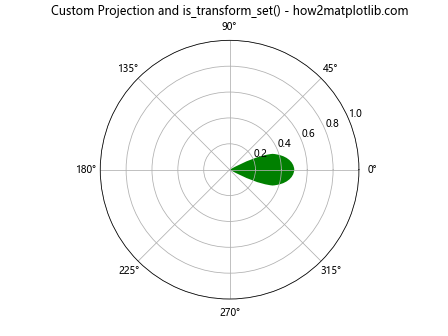
这个例子展示了如何在极坐标投影中使用is_transform_set()来管理圆形对象的变换。
结论
通过本文的详细探讨,我们深入了解了Matplotlib中Artist.is_transform_set()方法的作用和应用。这个方法在管理和检查Artist对象的变换设置时非常有用,特别是在处理复杂的图形、动画或交互式绘图时。
is_transform_set()方法允许我们:
1. 检查Artist对象是否已设置自定义变换
2. 在需要时应用默认变换
3. 在动态更新图形时有条件地修改变换
4. 在处理多个Artist对象时区分它们的变换状态
5. 在创建自定义Artist类时管理变换设置
通过合理使用is_transform_set()方法,我们可以更好地控制Matplotlib中的图形元素,创建更复杂、更灵活的可视化效果。无论是在简单的静态图形还是复杂的交互式应用中,掌握这个方法都将极大地提高我们使用Matplotlib的能力和效率。
 极客教程
极客教程